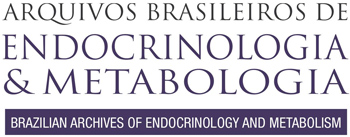CARTA AO EDITOR
Iodine nutrition: more is better?
Rosalinda Camargo; Meyer Knobel; Geraldo Medeiros-Neto
Thyroid Unit, Hospital das Clínicas, University of São Paulo Medical School, São Paulo, SP
Endereço para correspondência Endereço para correspondência: Geraldo Medeiros-Neto Departamento de Tireóide Hospital das Clínicas / FMUSP Av. Enéas de Carvalho Aguiar 255, 8º andar, bloco 05403-900 São Paulo, SP FAX (55-11) 3031-5194 E-mail: medneto@uol.com.br
THE PRESTIGIOUS JOURNAL "The New England Journal of Medicine" recently published an Editorial that summarizes the ill effects of iodine deficiency worldwide (1). However, in this publication it is recommended an iodine intake of 300 to 400 µg per day, far exceeding the recommendation of the "Fifth Report on the World Nutrition Situation", published by the Standing Committee on Nutrition, World Health Organization, Geneva, Switzerland, March 2004. In this Fifth Report, it is mentioned that excessive iodine intake (above 300 µg I/L urine) is associated with an increased risk of autoimmune thyroid disease (with hypothyroidism) and also with hyperthyroidism in the elderly (with the risk of atrial fibrillation).
We have recently noted the increased incidence of chronic autoimmnune thyroiditis among individuals exposed to more-than-adequate, or excessive, levels of iodine as indicated by excreted urinary iodine levels (2). In a recent population survey conducted in Brazil (São Paulo metropolitan area), after 5 years of excessive iodine intake by the population, 55% of the examined subjects had an urinary iodine excretion over 301 µg Iodine/L, with a median of 306 µg I/L (2). The prevalence of chronic autoimmune thyroiditis was 17.6% as compared to 9.4% in 1994, when a mild iodine deficiency was detected in a regional iodine nutrition survey in normal subjects from São Paulo city (median urinary iodine intake: 93 µg I/L) (3).
It should be noted that some of the increased incidence of Hashimotos thyroiditis found in our recent study (2) may be due to improved diagnostic methods. In the past few years, the diagnosis of autoimmune thyroid disease, especially chronic lymphocytic thyroiditis (Hashimotos disease), has been based on two main parameters:
1. hypoechoic ultrasound pattern that may objectively be measured by a Grey-scale analysis (4) and subjectively evaluated by a grade 3 or 4 hypoechoic pattern (5);
2. sera positive for anti-thyroid peroxidase (anti-TPO) antibody.
Using both parameters, the positive predictive value of the hypoechoic ultrasound pattern for detection of chronic thyroiditis (with positive anti-TPO antibodies) was 96%, whereas the absence of such hypoechoic image (grades 1 and 2) and a negative anti-TPO test had a negative predictive value of 91% (5). Some researchers may have underestimated the incidence of chronic autoimmune thyroiditis by using only one of these laboratory parameters (anti-TPO antibodies) in their assessments. For example, Teng et al. (6) used only positive anti TPO to diagnose autoimmune thyroiditis. This may explain the relatively low incidence of autoimmune thyroiditis in the high iodine intake Chinese population studied. Use of the more powerful 2-parameter diagnostic approach by researchers in this field would contribute to more meaningful study comparisons.
In conclusion: more-than-adequate, or excessive, iodine intake may lead to autoimmune thyroiditis and hypothyroidism (2,6). Therefore "Iodine nutrition, more is better" may not be a general recommendation to be followed for every population and for different countries in the world.
REFERENCES
1. Utiger RD. Iodine nutrition more is better. N Engl J Med 2006;354:2819-21, and 2006;355:1501.
2. Camargo RYA, Tomimori EK, Neves SC, Knobel M, Medeiros-Neto G. Prevalence of chronic autoimmune thyroiditis in the urban area neighboring a petrochemical complex and a control area in São Paulo. Clinics 2006;61(4):307-12.
3. Tomimori EK, Pedrinola F, Cavaliere H, Knobel M, Medeiros-Neto G. Prevalence of incidental thyroid disease in a relatively low iodine intake area. Thyroid 1995;5:273-6.
4. Mazzioti G, Sorvillo F, Iorio S, Carlone A, Romeo A, Piscopo M, et al. Grey-scale analysis allows a quantitative evaluation of thyroid echogenicity in patients with Hashimotos thyroiditis. Clin Endocrinol 2003;59:223-9.
5. Pedersen IB, Lawberg P, Knodsen N, Jorgensen T, Perrild H, Ovesen L, et al. A population study of the association between thyroid antibodies in serum and abnormalities in thyroid function and structure. Clin Endocrinol 2005;62:713-20.
6. Teng N, Shan Z, Teng X, Guan H, Li Y, Teng D, et al. Effect of iodine intake on thyroid diseases in China. N Engl J Med 2006;354:2783-93.
Recebido em 15/01/07
Revisado em 12/03/07
Aceito em 27/03/07
Endereço para correspondência:
Publication Dates
-
Publication in this collection
30 July 2007 -
Date of issue
June 2007

